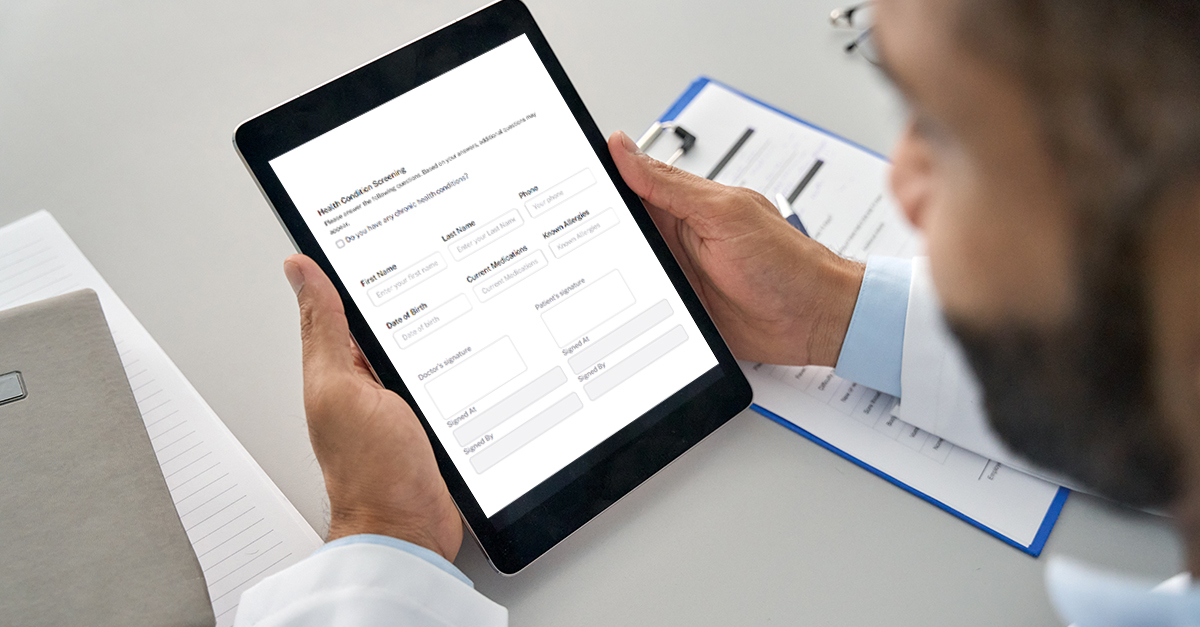5 Ways to Speed Up Patient Form Completion
07.10.2025
Managing new patient forms efficiently is key to running a smooth and organised healthcare practice. When forms are missing, incomplete, or handled manually, they can slow everything down. Patients wait longer. Staff get overwhelmed. Mistakes happen. A better system leads to faster check-ins, more accurate data, and a better experience for everyone involved. With the right tools and processes, new patient forms can go from a pain point to a powerful part of your clinic's workflow. In this post, we'll cover six best practices to help you simplify the process, reduce errors, and keep things running smoothly - without piles of paperwork.




 Managing new patient forms efficiently isn't just about saving time. It's about creating a smoother intake process, improving data accuracy, and setting the stage for better care. By following best practices like customising forms, sending them in advance, and training your staff properly, your clinic can reduce stress for both patients and your team. If you're ready to simplify the way you collect and manage patient information, Confil is here to help. Our platform offers customisable digital forms, secure storage, and automated workflows designed specifically for healthcare professionals. Whether you run a small private practice or a growing clinic, Confil helps you stay organised, compliant, and focused on patient care. Start building a better intake experience today and explore our FREE plan.
Managing new patient forms efficiently isn't just about saving time. It's about creating a smoother intake process, improving data accuracy, and setting the stage for better care. By following best practices like customising forms, sending them in advance, and training your staff properly, your clinic can reduce stress for both patients and your team. If you're ready to simplify the way you collect and manage patient information, Confil is here to help. Our platform offers customisable digital forms, secure storage, and automated workflows designed specifically for healthcare professionals. Whether you run a small private practice or a growing clinic, Confil helps you stay organised, compliant, and focused on patient care. Start building a better intake experience today and explore our FREE plan.
1. Use Digital Tools to Eliminate Paper New Patient Forms
Paperwork slows everything down. It takes time to print, scan, store, and organise, and it's easy to lose. Switching to digital new patient forms helps you avoid those problems entirely. With digital forms, patients can fill everything out online, even before they arrive at your clinic. This cuts down on wait times and reduces pressure at the front desk. For your staff, it means no more sorting through stacks of paper or struggling to read messy handwriting. Digital tools also allow for easier updates. If your form needs a new question, you can make the change in seconds without reprinting anything. Most platforms also let you export form data directly into your electronic health record (EHR) system. Using digital new patient forms improves accuracy, saves time, and creates a better experience for both patients and staff. It's one of the simplest ways to modernise your practice and reduce daily stress.
2. Customise Forms to Match Your Clinic’s Workflow
Not every clinic needs the same information from every patient. A one-size-fits-all form can lead to confusion, incomplete answers, or wasted time. That's why it's important to customise your new patient forms to reflect your clinic's services, specialties, and workflow. Start by reviewing your current intake process. Are there questions your staff always has to ask in person because they're missing from the form? Are patients overwhelmed with fields that don't apply to them? Customising the form allows you to collect only what's necessary and skip the rest. For example, a dental practice might include questions about oral health habits, while a physical therapy clinic may ask about mobility or pain history. You can also adjust forms based on patient type, such as new patients, follow-ups, or specialty consultations. Well-designed new patient forms reduce confusion and improve accuracy. They also make it easier for staff to review responses and take action quickly.
3. Make Forms Available Before the Appointment
One of the easiest ways to speed up the intake process is to send new patient forms before the appointment. When patients fill out forms at home, they're more relaxed and less likely to make mistakes or leave things blank. This also means they won't be rushed in the waiting room or held up at check-in. You can send forms by email, text message, or through your clinic's patient portal. Many digital form platforms let you automate this step, so forms are sent out as soon as a new appointment is booked. That way, your staff doesn't have to follow up manually. Providing forms in advance also gives patients time to gather important details, like medication lists or family medical history. And when the forms are submitted before the visit, your team has time to review the information and prepare. Making new patient forms available ahead of time helps reduce delays, improve accuracy, and create a smoother experience for everyone.
4. Include Smart Fields and Required Inputs
Smart design makes a big difference when it comes to collecting accurate information. By using dropdowns, checkboxes, and required fields, you can make your new patient forms easier to complete and less prone to errors. For example, instead of asking patients to type in "Yes" or "No," give them buttons to choose from. Use dropdown menus for common answers like medical conditions, insurance providers, or medication types. This prevents typos and ensures that responses are consistent across all submissions. Required fields are just as important. They make sure that patients can't skip critical questions, like allergies or emergency contacts. This saves your staff from having to track down missing information later. You can also add helpful prompts or examples next to each field. This guides patients and reduces confusion about what's being asked. Adding smart features to your new patient forms makes them more user-friendly and reliable. It's a simple way to collect better data without adding more work for your team.
5. Train Staff on Proper Form Handling and Follow-Up
The effectiveness of new patient forms depends on how well your team uses them. Even with the best digital tools, confusion or delays can happen if staff are unsure of the process. That's why clear training is essential. Start by walking your team through the full intake workflow. Everyone should know where to find completed forms, how to store them securely, and what steps to take before each appointment. Create a simple checklist that covers everything, including reviewing required fields, identifying medical alerts, confirming insurance details, and uploading the form to the patient's file. It's also important to have a follow-up routine in place. If a patient hasn't submitted their new patient forms ahead of time, your staff should know how and when to reach out with a reminder. A quick message or phone call can prevent last-minute delays. When everyone follows the same system, intake becomes faster, more accurate, and far less stressful for both patients and staff.
6. Keep Forms Secure and Compliant
Patient forms contain sensitive information. That's why security and compliance should always be a top priority when managing new patient forms. If your clinic handles forms manually or uses outdated tools, you may be at risk of data breaches or non-compliance with regulations like HIPAA. Start by choosing a platform that offers secure encryption, access controls, and cloud-based storage. This helps protect data from unauthorised access and makes it easier to manage everything in one place. It also reduces the risk of lost or damaged files. You should also limit access to form data. Only authorised staff members should be able to view or edit patient information. Audit trails and automatic backups are also helpful for monitoring activity and keeping records safe. Using a secure system for new patient forms shows patients that their privacy matters. It also protects your practice from legal and financial risks, while keeping your documentation organised and accessible. Managing new patient forms efficiently isn't just about saving time. It's about creating a smoother intake process, improving data accuracy, and setting the stage for better care. By following best practices like customising forms, sending them in advance, and training your staff properly, your clinic can reduce stress for both patients and your team. If you're ready to simplify the way you collect and manage patient information, Confil is here to help. Our platform offers customisable digital forms, secure storage, and automated workflows designed specifically for healthcare professionals. Whether you run a small private practice or a growing clinic, Confil helps you stay organised, compliant, and focused on patient care. Start building a better intake experience today and explore our FREE plan.
Managing new patient forms efficiently isn't just about saving time. It's about creating a smoother intake process, improving data accuracy, and setting the stage for better care. By following best practices like customising forms, sending them in advance, and training your staff properly, your clinic can reduce stress for both patients and your team. If you're ready to simplify the way you collect and manage patient information, Confil is here to help. Our platform offers customisable digital forms, secure storage, and automated workflows designed specifically for healthcare professionals. Whether you run a small private practice or a growing clinic, Confil helps you stay organised, compliant, and focused on patient care. Start building a better intake experience today and explore our FREE plan. 